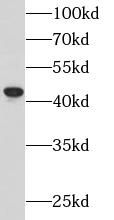Products
APOBEC3G antibody
| Synonyms: | DNA dC->dU-editing enzyme APOBEC-3G|APOBEC-related cytidine deaminase (APOBEC-related protein antibody, ARCD)|APOBEC-related protein 9 (ARP-9)|CEM-15 (CEM15)|Deoxycytidine deaminase (A3G)|APOBEC3G antibody | ||
| Catalogue No.: | FNab00495 | Reactivity: | Human, Mouse |
| Host: | Rabbit | Tested Application: | ELISA, WB, IHC, IF |
| Clonality: | polyclonal | Isotype: | IgG |
| Size | Price |
|---|---|
| 100µg | Inquiry |
- SPECIFICATIONS
- FIGURES
- CONDITIONS
- FAQS
- Product Name
- APOBEC3G antibody
- Catalogue No.
- FNab00495
- Size
- 100μg
- Form
- liquid
- Purification
- Immunogen affinity purified
- Purity
- ≥95% as determined by SDS-PAGE
- Clonality
- polyclonal
- Isotype
- IgG
- Storage
- PBS with 0.02% sodium azide and 50% glycerol pH 7.3, -20℃ for 12 months(Avoid repeated freeze / thaw cycles.)
- Immunogen
- apolipoprotein B mRNA editing enzyme, catalytic polypeptide-like 3G
- Alternative Names
- DNA dC->dU-editing enzyme APOBEC-3G|APOBEC-related cytidine deaminase (APOBEC-related protein antibody, ARCD)|APOBEC-related protein 9 (ARP-9)|CEM-15 (CEM15)|Deoxycytidine deaminase (A3G)|APOBEC3G antibody
- UniProt ID
- Q9HC16
- Observed MW
- 46 kDa
- Tested Applications
- ELISA, WB, IHC, IF
- Recommended dilution
- WB: 1:200-1:1000; IHC: 1:20-1:200; IF: 1:20-1:200
 mouse colon tissue were subjected to SDS PAGE followed by western blot with FNab00495(APOBEC3G Antibody) at dilution of 1:100
mouse colon tissue were subjected to SDS PAGE followed by western blot with FNab00495(APOBEC3G Antibody) at dilution of 1:100
 Immunohistochemistry of paraffin-embedded human testis tissue slide using FNab00495(APOBEC3G Antibody) at dilution of 1:200
Immunohistochemistry of paraffin-embedded human testis tissue slide using FNab00495(APOBEC3G Antibody) at dilution of 1:200
 Immunofluorescent analysis of MCF-7 cells using FNab00495 (APOBEC3G antibody) at dilution of 1:50 and Alexa Fluor 488-conjugated Goat Anti-Rabbit IgG(H+L)
Immunofluorescent analysis of MCF-7 cells using FNab00495 (APOBEC3G antibody) at dilution of 1:50 and Alexa Fluor 488-conjugated Goat Anti-Rabbit IgG(H+L)
- Background
- DNA deaminase(cytidine deaminase) which acts as an inhibitor of retrovirus replication and retrotransposon mobility via deaminase-dependent and-independent mechanisms. Exhibits potent antiviral activity against vif-deficient HIV-1. After the penetration of retroviral nucleocapsids into target cells of infection and the initiation of reverse transcription, it can induce the conversion of cytosine to uracil in the minus-sense single-strand viral DNA, leading to G-to-A hypermutations in the subsequent plus-strand viral DNA. The resultant detrimental levels of mutations in the proviral genome, along with a deamination-independent mechanism that works prior to the proviral integration, together exert efficient antiretroviral effects in infected target cells. Selectively targets single-stranded DNA and does not deaminate double-stranded DNA or single-or double-stranded RNA. Exhibits antiviral activity also against simian immunodeficiency viruses(SIVs), hepatitis B virus(HBV), equine infectious anemia virus(EIAV), xenotropic MuLV-related virus(XMRV) and simian foamy virus(SFV). May inhibit the mobility of LTR and non-LTR retrotransposons.
How many times can antibodies be recycled?
First, usually it's not suggested to recycle antibodies. After use, buffer system of antibodies has changed. The storage condition of recycled antibodies for different customers also varies. Thus, the performance efficiency of recycled antibodies can’t be guaranteed. Besides, FineTest ever conducted the antibody recycling assay. Assay results show recycling times of different antibodies also varies. Usually, higher antibody titer allows more repeated use. Customers can determine based on experimental requirements.
Notes: After incubation, we recycle rest antibodies to centrifuge tube and store at 4℃. High titer antibodies can be stored for a minimum of one week. Reuse about three times.
What are components of FineTest antibody buffer?
Components of FineTest antibody buffer are usually PBS with proclin300 or sodium azide, BSA, 50% glycerol. Common preservative is proclin300 or sodium azide, which is widely applied in the lab and industry.
How about the storage temperature and duration of FineTest antibodies?
Most antibodies are stored at -20℃. Directly-labeled flow cytometry antibodies should be stored at 2 - 8℃. The shelf life is one year. If after sales issues for purchased antibodies appear, return or replacement is available. Usually, antibodies can be still used after the one-year warranty. We can offer technical support services.
Is dilution required for FineTest antibodies? What’s the dilute solution?
Directly-labeled flow cytometry antibodies are ready-to-use without dilution. Other antibodies are usually concentrated. Follow the dilution ratio suggested in the manual. Dilute solution for different experiments also varies. Common antibody dilution buffers are acceptable(e.g. PBST, TBST, antibody blocking buffer).
How to retrieve antibodies for immunohistochemistry?
Common retrieval buffers: Tris-EDTA Buffer(pH 9.0); Citrate Buffer(pH 6.0)
Heat induced antibody retrieval:
Method 1: Water-bath heating: Put the beaker with retrieval buffer and slide in the boiling water bath. Keep the boiling state for 15min. Naturally cool to room temperature;
Method 2: Microwave retrieval: Put the beaker with retrieval buffer and slide in the microwave oven. Heat at high power for 5min, Switch OFF for 3min, Heat at medium power for 5min. Naturally cool to room temperature.
How to choose secondary antibodies?
(1) Secondary antibodies react with primary antibodies. Thus, secondary antibodies should be against host species of primary antibodies. E.g. If the primary antibody is derived from rabbit, the relevant secondary antibody should be against rabbit. E.g. goat anti rabbit or donkey anti rabbit.
(2) Choose secondary antibody conjugates according to the experimental type, e.g. ELISA, WB, IHC etc. Common enzyme conjugated secondary antibodies are labelled by HRP, AP etc. Fluorescin or dye labelled secondary antibodies are applied in immunofluorescence and flow cytometry(e.g. FITC, Cy3).
